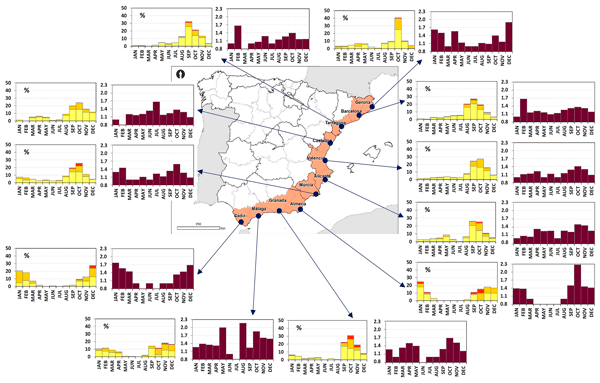Natural catastrophes in 2020 totaled $210 billion dollars
- CATRisk Consultants

- 22 feb 2021
- 3 Min. de lectura
Actualizado: 7 mar 2021
2020 natural catastrophes
Overall losses from world-wide natural catastrophes in 2020 totaled $210 billion dollars, significantly higher than $166 billion in 2019, according to Munich Re. There were 980 events that caused losses in 2020, compared with 860 events in 2019. Insured losses from the 2019 events totaled $82 billion. Natural catastrophes in 2020 caused 8,200 deaths, compared with 9,435 in 2019.
Natural and Man-made Disasters
Swiss Re collects data on global insured losses resulting from both natural catastrophes and man-made disasters. Besides including man-made disasters, Swiss Re’s figures differ from Aon’s because Swiss Re uses different collection methods and criteria for classifying events. According to Swiss Re’s February 2020 global losses report, insured losses totaled $60 billion in 2019, down from $93 billion in 2018, and below the previous 10-year average of $75 billion. While the decrease in losses from 2018 to 2019 was mostly due to the decline in hurricane losses in the United States, the global 2019 losses were driven by severe weather along with socio-economic factors such as economic development and increases in urban population. The report notes that a number of smaller- and medium-sized events, such as events that occur as a secondary effect of a primary event and defined as secondary perils, for example, a tsunami following an earthquake, accounted for the majority of losses in each year from 2017 to 2019.
Of the 317 disasters in 2019, 202 were natural catastrophes, and 115 were man-made. Natural disasters resulted in $52 billion in losses, compared with $84 billion in 2018. Man-made disasters accounted for the remaining $8 billion in losses, compared with $9 billion in 2018. In 2019, 11,500 people worldwide perished or were missing in natural and man-made disasters. Typhoons Faxai and Hagibis in Japan drove natural catastrophe losses.
Swiss Re estimates that global natural and man-made catastrophe losses for 2020 will total $83 billion, the fifth costliest year on record since 1970. 2020 losses were impacted by the record number of severe convective storms (thunderstorms with tornadoes, hail, floods and lightning) and wildfires in the United States. These perils, and other secondary perils, accounted for 70 percent or about $53 billion of the $76 billion in insured losses from natural catastrophes. Hurricanes added another $20 billion in insured losses. Man-made catastrophes made up the remainder.
Nuclear incidents
The International Atomic Energy Agency (IAEA) rates the severity of nuclear incidents on the International Nuclear and Radiological Event Scale (INES) from one (indicating an anomaly) to seven (indicating a major event). The scale considers an event’s impact based on three criteria: its effect on people and the environment; whether it caused unsafe levels of radiation in a facility; and if preventive measures did not function as intended. Scales six and seven designate full meltdowns, where the nuclear fuel reactor core overheats and melts. Partial meltdowns, in which the fuel is damaged, are rated four or five.
Japan’s Nuclear and Industrial Safety Agency assigned a rating of seven to the March 2011 accident at Japan’s Fukushima Daiichi nuclear power plant. The 1986 Chernobyl accident in the former Soviet Union is the only other incident to rate a seven. The Chernobyl incident killed 56 people directly and thousands of others indirectly through cancer and other diseases. The 2011 incident released high amounts of radiation and caused widespread evacuations in affected areas but only one death to date.



















Comments